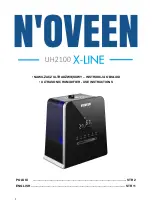
34
to the floor. The two screws on the sides, con-
nected to the rear wheels of the squeegee (Photo
E - 6), are to adjust the pressure of the squeegee
to the floor.
When the squeegee is perfectly adjusted, the rear
squeegee blade, sliding as it moves, bends in all
points forming an angle of 45° with the floor.
As the machine operates (advances), it is possible
to operate on the inclination knob and pressure
screws ( Photo E - 4 ; Photo E - 6 ) to adjust the
inclination and pressure of the squeegee blades on
the floor.
Squeegee drying must be uniform along the entire
drying line: damp patches mean that drying is in-
sufficient; turn the adjustment knobs to optimise
drying.
7.2.5
SPLASH GUARD ASSEMBLY/DISAS-
SEMBLY
The splash guard is attached to the brush plate
(Photo A - 6) by interlocking on the plastic cover.
To remove the splash guard is sufficient to pull it
down until it detaches from the plastic cover.
To replace the splash guard,push it into the bot-
tom edge of the plastic cover from one end and
continue pushing up to the other end.
7.3 ACCESSORY
ASSEMBLY/DISAS-
SEMBLY (BRUSHES, PAD DRIVERS AND
ABRASIVE DISKS)
Never use the machine if brushes or pad drivers
and abrasive disks are not perfectly installed.
Assembly:
Make sure that the brush plate is raised; otherwise
lift it by following the instructions provided in the
specific section.
Make sure that the ignition key on the control panel
is in position “0”.
Bring the brushes (or the guide disks equipped
with abrasive disks) near the connections, under
the brush plate; lift them, bring them through the
centering flange, and turn them opposite the rota-
tion direction until you hear the stable “click” con-
nection.
Do not allow the length of the rows of brushes
to become lower than 1 cm.
Do not allow the thickness of the abrasive disks
to become less than 1 cm.
Working with excessively worn brushes or exces-
sively thin abrasive disks may damage the machine
and the floor.
Regularly check the wear on these parts before
starting to work.
Disassembly or replacement:
Make sure that the brush plate is raised; otherwise
lift it by following the instructions provided in the
specific section.
Make sure that the ignition key on the control panel
is in position “0”.
While holding the brushes (or the guide disks) with
the hands under the plate, turn them in the rota-
tion direction while lowering to release them from
the guide plate.
7.4
FILLING AND DRAINING THE DE-
TERGENT SOLUTION TANK
☞
The temperature of the water or the deter-
gent should never exceed 50°C.
☞
Always empty the detergent solution tank before
filling it up.
To fill the solution tank:
• Remove the plug in the back of the machine.
• Leave some space between the mouth of the
plug and the liquid level.
• Add the required quantity of the chemical prod-
uct, considering the percentage indicated by the
supplier, with reference to the full tank capacity
listed on the product sheet.
• Use only those products suitable for the floor and
the dirt to be removed.
The machine was designed to be used
with non-foaming and biodegradable deter-
gents made specifically for scrubber-driers.
The use of other chemical products (such as
sodium hypochlorite, oxidisers, solvents or
hydrocarbons) may damage or destroy the
machine.
• Follow the safety regulations specified in the
relative section and indicated on the detergent
container.
• Contact the machine manufacturer to obtain a
complete list of available and suitable detergents.
• •Always add the detergent after filling the tank
with water to prevent foam from being created in-
side.
• Do not leave the water hose unattended and
insert it completely into the tank: the hose might
move and get sensitive parts of the machine wet.
• Close the tank cover.
To drain the solution water tank:
• Open the valve located at the bottom of the
machine in the back ( Photo D - 1 ) and wait until
the tank has been completely emptied.
• Close the drain valve.
7.5
DRAINING THE RECOVERY TANK
The dirty water must be drained in accordance with
national regulations.
The user is completely responsible for ensuring
compliance with such rules.
After the detergent solution is finished, always
empty the recovery tank before filling it again.
In general, the recovery tank can be emptied
whenever required, and even during intermediate
phases of the work cycle.
Always empty the recovery tank before lifting it
to avoid health problems for operators and to avoid
damaging the machine.
The recovery tank volume is higher than the de-
tergent solution volume, therefore a potentially
Summary of Contents for KF 675BBC
Page 2: ......
Page 3: ...2 ESPA OL ES PAGINA 10 ENGLISH EN PAGE 26 FOTOGRAFIAS PHOTOGRAPHS PAGINA PAGE 3...
Page 4: ...3 1 2 A B 1 5 4 2 7 4 5 6 9 8 3 3...
Page 5: ...4 C 1 1 D 3 4 2...
Page 6: ...5 3 3 2 1 4 6 7 6 7 1 2 5 E F 1...
Page 7: ...6 H 2 G 1 3 3 1 4 2...
Page 9: ...8 1 L 2 2 4 1 M 3...
Page 10: ...9 N O 1 2 2 3 6 7 5 4 0 8 1 7 2 2 2 9 4 3 0 4 H2O CHEM 1 2 1 1 1 0 1 3 1 7 2 5 1...
Page 44: ......












































